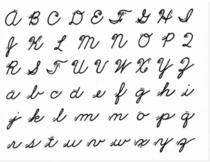Teaching cursive early may be a message at gge beginning but if done well results in excellent handwriting as they grow up
Gransnet forums
Education
Cursive Handwriting in Schools
(84 Posts)A while back I was horrified to see my grandson's handwriting which was illegible! Apparently instead of teaching them the letters of the alphabet separately they have tails on the front and back so they find it easier to do 'joined up' handwriting.
They say this helps them join up their handwriting more quickly and easily. I just hope so because it looks a flippin' mess to me. Anyone got any feedback on this?
Elrel Fri 05-Jun-20 09:24:41Does anyone remember the perfect copperplate which was used on railway station chalkboards? Beautiful, legible, written with care and pride to tell us of train delays and cancellations!
Elrel In the first term of my Grammar School back in 1957 we were taught italic script using a broad italic nib. (We had special nibs for the left handed.) The style wasn't enforced and there was no other tuition in handwriting style after that first term.
Some of us just took to it, me included. It became an art form for me. I learned that if you use a lined template of equidistant horizontal, vertical and diagonal lines, underneath the page that you are writing on, you can achieve a uniform dimension to each letter.
Taking that one stage further, if it's something like a wedding album or a curriculum vitae, I would write out the letter in pencil, then measure and adjust each letter to a standard not unlike the printed word. This not only ensures uniformity it also works like a spellchecker, if you make a spelling mistake or accidentally omit a word, it can be very frustrating.
Following that I would write over the pencil in ink using the broad italic nib. When that was finished and completely dry I can now use that as a perfect template. Just place it under the page that is to be written on and write following the template. Perfect copperplate. I can do it freehand too, but not quite as good as the above method.
It is time consuming of course but it's a hobby of mine. Over the years I learned a few styles, Old English Gothic is one that making a mistake on can turn the air blue.
Copperplate handwriting has always made an impression, or at least got a response, but by and large I just write freehand with a fountain pen and italic nib using a horizontal lined template underneath.
My grandmother, at school in the 1890s wrote exactly like that, but with a slight slope to the right, I was taught the same way in the 40s/50s. My handwriting now is appalling as a result of using computers/laptops/iPads over the years. My shopping list always leads to difficulties because I can’t read my own writing.
My son has used some of the lockdown time to teach his eldest son to learn cursive script and to use a fountain pen. I promised DGS that when he could write me a letter, I would send him a beautiful fountain pen from my collection. At the end of last week, I received a beautifully written letter, and duly sent off the pen. A few days later, my son sent me a delightful video of my grandson writing confidently and beautifully with his new pen. Result!
We had handwriting lessons until we were 10 or 11, pages of patterns! We were taught Marion Richardson in the late 50s. Her sister taught us art in the upper school.
Marion Richardson (patterns and handwriting style) was taught for decades, I learnt it in the ‘40s and have some MR books still.
As PenE posted it is most important that the correct direction of forming printed letters is taught first, joining should follow easily. If individual letters are formed in the wrong direction joining is confusing and difficult for the child.
Legibility is key, of course, whatever style is used. Some italic writing can be difficult to read. Does anyone remember the perfect copperplate which was used on railway station chalkboards? Beautiful, legible, written with care and pride to tell us of train delays and cancellations!
I used to be an examiner for GCSE Biology and we were told to award a SPAG mark ie for spelling, punctuation & grammar. I think the scale was only 1-3 or maybe 1-5 and the marks were added not subtracted. It would make little difference to the end grade and was very subjective!
The rubric on all Scottish exam papers was, unforgettably
Marks will be deducted for bad spelling, bad punctuation and for writing that is difficult to read
Thank you for reminding me of that annodomini - the exam board would have had a field day with 21st century social media!
I was taught italic , we used proper pens with an ink pot. If I can write with a proper pen my handwriting is fine , give me a Biro and it's illegible .
Many years ago a.friend gave me some exercise books to practice handwriting with my children, they were used in Steiner schools , I seem to remember they had different coloured covers with tiny dots , very slim paper backs . The idea was to use tracing paper over the scripts . Does anyone know what they were called as I would love to use them with my grandchildren.
On the way to learning cursive handwriting in the 1940s, we began with 'pot-hooks', the building blocks of many letters. Then we had to learn to make the letters and join them up. I was never very good at that, and by the time I was 15, I was losing marks for my illegible writing. The rubric on all Scottish exam papers was, unforgettably:
'Marks will be deducted for bad spelling, bad punctuation and for writing that is difficult to read'.
My dad bought me a book on italic writing which I enjoyed and took to calligraphy enthusiastically. My teachers were pleasantly surprised that my writing had suddenly become legible, if unconventional.
I was initially taught plain, ‘round’ handwriting, which was later joined up.
At 9 we moved area and my new school taught the (to my family) old-fashioned ‘loopy’ handwriting.
Roll on 2 years and my senior school wanted us writing italic, with italic fountain pens.
3 styles in 4 years - I can honestly say my handwriting never recovered. I still remember the red ink comments beneath my homework - ‘Writing MUST improve!’
I think children have been taught to write letters with tails & hooks to enable easy joined up for a long time. My children certainly did in the 70s & 80s and also all the grandchildren of various ages. I was at school in the 50s and like others learned printing first and a fancy joined up style later - we virtually had to learn letter formation twice. It seems sensible to learn one style from the start even if it looks weird to us in the early stages.
Like this at earlier stages but adapting later to a semi-italic style without fussy embellishments.
I was taught cursive writing in (Scottish) primary school in the 50's. During my PGCE year I 'relearned' using what is referred to here as the Marion Richard's style although I 've never heard that label.
That's the semi-italic style I adopted and taught for many years. I much prefer it its clean lines to the fussy old-fashioned traditional cursive.
Free essay examples say there are a whole philosophy in writing cursive
Are there? ?????????.
FFS do you people never give up?
You
Are
Wasting
Your
Time
(And mine, which is more important) ???????
Message deleted by Gransnet. Here's a link to our Talk Guidelines.
Message deleted by Gransnet. Here's a link to our Talk Guidelines.
Both my granddaughters are being taught to write like that - with tails on -. One is 8, the other 5 yrs old.
Bluebelle, yes, it does take you by surprise to get a letter from yourself! 
I can’t remember how I learnt, nor how my dc learnt to write.  There might be a few old books in the attic that has their handwriting in.
There might be a few old books in the attic that has their handwriting in.
BlueBelle When did this teaching printing take place as I learned joined up in the 50 s my children did joined up in the 70 s and my grandkids have learnt joined up in the 2000 s ?
As I discovered when I looked at my old handwriting it seems a lot of children were taught single letters first and then had to learn a different style later to join the letters. You can see this very clearly in my two handwriting examples, one aged 6 with single letters and the other aged 8 when I must have learnt cursive.
An OT once told me that children with illegible writing need fine motor skills help first but not before more practice with gross motor skills and whole body awareness. It all refined down to be able to write neatly and legibly. So those PE lessons weren’t wasted. ?
If I see adults printing not joining up I think it looks really childish I truly admit I m being wrongly judgemental but that’s the first thing that comes into my mind
It’s also so time consuming to take the pen off after each letter it’s so much easier to move along in a continuous flow
When did this teaching printing take place as I learned joined up in the 50 s my children did joined up in the 70 s and my grandkids have learnt joined up in the 2000 s ?
It does help letter formation because apart from the x you don't have to take your pencil off the page. I must admit I find it a struggle sometimes as my writing wasn't joined up but practise makes perfect. Our school changed to it so children who have already learned to write are now learning cursive and it's hard to reteach writing style x
Join the conversation
Registering is free, easy, and means you can join the discussion, watch threads and lots more.
Register now »Already registered? Log in with:
Gransnet »


